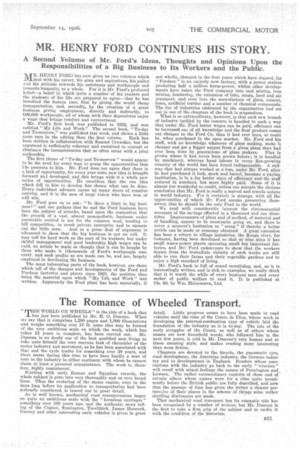The Romance of Wheeled Transport.
Page 49

If you've noticed an error in this article please click here to report it so we can fix it.
" THE WORLD ON WHEELS" is the title of a book that has just been published by Mr. H. 0. Duncan. When we say that it comprises 1,200 pages and 1,300 illustrations and weighs something over 13 lb. some idea may be formed of the very ambitious scale on which the work, which has
taken 15 years to complete, has been carried out. Mr. Duncan is no doubt one of the best qualified men living to take unto himself the very onerous task of chronicler of the motor industry and movement, as he has been associated with that and the cycle trades for something over 30 years, and there seems during this time to have been hardly a man of note in the industry in either continent with whom he cannot claim at least a personal acquaintance. The work is, therefore, highly reminiscent.
Starting with early Roman and Egyptian records, the whole subject is gone into very thoroughly and on very broad lines. Thus the evolution of the steam engine, even in the days Jong before its application to transportation had been seriously considered, is traced out in great detail.
As is well known, mechanical road transportation began on quite an ambitious scale with the " horseless carriages" something over 100 years ago, and the authentic story telling of the Cugnot, Symington, Trevithick, James Hancock, Gurney and other interesting early vehicles is given in great detail. Little progress seems to have been made in road vehicles until the time of the Comte de Dion, Whose work in developing the internal-combustion type of vehicle laid the foundation of the industry as it is to-day. The tale of the early struggles of the Count, as well as of others whose names are now household words, who followed him in the next few years, is told in Mr. Duncan's very human and at times amusing style, and makes reading more interesting than most fiction.
Chapters are devoted to the bicycle, the pneumatic tyre, road development, the American industry, the German industry and to developments in England. Readers whose associations with the industry go back to the early " 'nineties " will recall with mixed feelings the names of Pennington and Lawson. The rather extraordinary exploits of these and of certain others whose names were for a time quite prominently before the British public are fully described, and now that the passage of time has given the writer a clearer perspective of their places in the scheme of things seine rather startling disclosures are made.
That mechanical road transport has its romantic side has been recognized by a number of writers, but Mr. Duncan is the first to take a firm grip of the subject and to tackle it with the erudition of the historian.




































































































